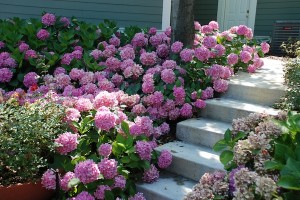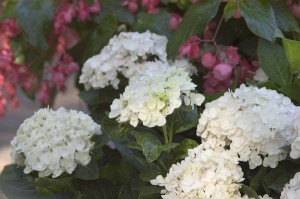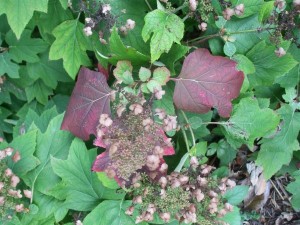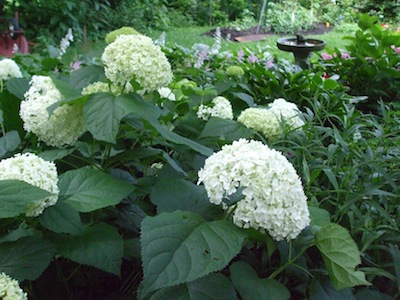
Limelight (Hydrangea paniculata) flowers turn pink as they age. Photo courtesy Proven Winners/ColorChoice
One of the showier shrubs in the garden is one that offers year-round interest. Hydrangeas, with their moptop and lacecap flowers, grab centerstage in the summer garden. And, they hold a place for two more acts as their flowers dry to autumn hues, then winter whites.
There are two basic types of hydrangeas (Hydrangea), those that bloom on year-old growth and those that bloom on current season growth. Some newer cultivars bloom on old and new wood.
The big-leaf hydrangea (H. macrophylla) forms its flower buds in late summer and fall. In the upper Midwest and other cold climates, freezing temperatures in late spring frequently zap these buds, causing the plant to grow leaves, but no blooms.

Let's Dance Moonlight big leaf hydrangea blooms on new and old growth. Photo courtesy GreatGardenPlants.com
You can reduce this threat by siting a big leaf hydrangea where it is buffered from drying winds and freezing temperatures. Many northern gardeners protect it by making a sleeve to fit around the plant and filling it with leaves in fall. The leaf-stuffed sleeve stays on the plant until spring, when there’s no danger of a hard freeze. The sleeve can be made of cloth, such as burlap, or it can be a plastic trash can with the bottom cut out.
Most big-leaf hydrangea is better suited for the more moderate climates in the West, South and Southeast. H. serrata is another popular hydrangea that blooms on year-old growth and can be susceptible to flower bud damage from cold temperatures. If you need to prune these hydrangeas do so within a month after it blooms.

Blushing Bride in Bailey Nurseries' Endless Summer Hydrangea series, has white flowers with a blush of pink. Photo courtesy Bailey Nurseries
Several breeders have introduced big leaf hydrangeas that bloom on current season and year-old growth. The Endless Summer, Forever and Ever and Let’s Dance series of plants are in this group. The color of the flowers on these hydrangeas depends on the soil. Acidic soil produces flowers in the blue range and hydrangeas planted in alkaline soil have blooms in the pink palette. You can add alumninum sulphate to hydrangeas planted in alkaline soil to turn them blue and lime to those planted in acidic soil to turn them pink.
Although the native oakleaf hydrangea (H. quercifolia) blooms on year-old growth, it does so later in the season so its flower buds are less likely to be damaged by freezing temperatures in spring, making it quite reliable in northern gardens. Oakleaf hydrangeas have cone-shaped flowers that turn pinkish as they age, persisting on the plant well into winter. The leaves on this hydrangea turn a leathery, wine-red in fall and stay on the plant through winter and into spring. The bark flakes off, called exfoliating, to reveal a cinnamon color. Some cultivars to consider: ‘Alice’, ‘Pee Wee’, ‘Snowflake’, ‘Snow Queen’ and ‘Sikes (Sykes) Dwarf’.

The colors have begun to change on the oakleaf hydrangea. (C) Jo Ellen Meyers Sharp
The most reliable selections for cold climates are the native smooth-leaf hydrangea (H. arborescens) and H. paniculata, commonly referred to as peegee hydrangea, from Asia. Both of these hydrangeas bloom on current season growth, which means you can prune them in spring without cutting of summer’s flowers. The flower colors on these hydrangeas cannot be altered by soil additives.
Popular smooth-leaf hydrangeas are the mop-top ‘Annabelle’ and the lace-cap ‘White Dome.’ ‘Invincibelle Spirit’ and ‘Annabella’ (H. arborescens) are breeding breakthroughs because they bloom with pink moptop flowers.
A tremendous amount of breeding is going on with the peegee hydrangeas. These form cone-shaped flowers, called panicles, that take on various hues of white, green or pink.
Breeders are working on plants with flowers that turn pink faster or bloom in pink. Some of the best H. paniculata are: ‘Tardiva’, ‘Pinky Winky’, ‘Quick Fire’, ‘Strawberry Vanilla’, ‘Limelight’ and ‘Little Lime’.
Plant hydrangeas in shade to part sun. They tolerate full sun, but will need supplemental watering. All hydrangeas do best in soil rich in organic matter and when given a good, periodic soaking during hot, dry spells. The native smooth-leaf hydrangea can handle fairly wet to dry spots.
Apply about an inch of compost, rotted manure or other organic matter to the soil around hydrangeas in spring as they start to develop their leaves and in fall. If using a soil additive or hydrangea fertilizer, always read and follow the label directions.

Annabelle (Hydrangea arborescens) is a long-blooming cultivar of a native plant. (C) Jo Ellen Meyers Sharp
 You Can Grow That! is the meme created by C.L. Fornari at Whole Life Gardening. The 4th of every month, several bloggers post columns that encourage gardeners to grow plants.
You Can Grow That! is the meme created by C.L. Fornari at Whole Life Gardening. The 4th of every month, several bloggers post columns that encourage gardeners to grow plants.